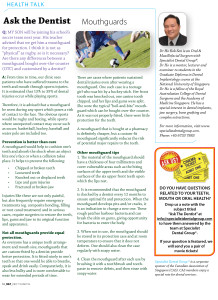 Q: My son will be joining his school’s soccer team next year. His teacher advised that we get him a mouthguard for protection. I think it is not as “physical” as rugby, so is it necessary? Are there any differences between a mouthguard bought over-the-counter (OTC) and customised by a dentist?
Q: My son will be joining his school’s soccer team next year. His teacher advised that we get him a mouthguard for protection. I think it is not as “physical” as rugby, so is it necessary? Are there any differences between a mouthguard bought over-the-counter (OTC) and customised by a dentist?
A: From time to time, our clinic sees patients who have suffered trauma to the teeth and mouth through sports injuries. It is estimated that 13% to 39% of dental injuries occur while playing sports.
Therefore, it is advised that a mouthguard be worn during any sport which poses a risk of contact to the face. The obvious sports would be rugby and boxing, while sports where unexpected contact may occur such as soccer, basketball, hockey, baseball and water polo are included too.
Prevention is better than cure
A mouthguard would help to cushion one’s teeth and absorb the shock when an object hits one’s face or when a collision takes place. It helps to prevent the following:
• Chipped or broken teeth
• Loosened teeth
• Knocked out or displaced teeth
• Lips and gum injuries
• Fractured or broken jaw
Injuries like these are not only painful, but also frequently require emergency treatments (eg. composite bonding, filling or root canal treatment) and in serious cases, require surgeries to restore the teeth, lips, gums and jaw to its original function and appearance.
Not all mouthguards provide equal protection
As everyone has a unique teeth arrangement and mouth size, mouthguards that are custom-fitted by a dentist provide better protection. It is fitted nicely to one’s teeth so that one would be able to breathe, speak and drink easily. Comparatively, it is also less bulky and is more comfortable to wear for extended periods of time.
There are cases where patients sustained dental injuries even after wearing a mouthguard. One such case is a teenage girl who was hit by a hockey stick. Her front tooth was knocked out, one canine tooth chipped, and her lips and gums were split. She wore the typical “boil-and-bite” mouthguard which can be bought over-the-counter. As it was not properly fitted, there were little protection for the teeth.
A mouthguard that is bought at a pharmacy is definitely cheaper, but a custom-fit mouthguard significantly reduces the risk of potential major repairs to the teeth.
Other mouthguard tips:
- The material of the mouthguard should have a thickness of four millimetres and cover vulnerable areas such as the biting surfaces of the upper teeth and the visible surfaces of the six upper front teeth upon which the lips rest.
- It is recommended that the mouthguard is checked by a dentist every 12 months to ensure optimal fit and protection. When the mouthguard develops pits and/ or cracks, it is an indication to change a new one. These rough patches harbour bacteria and can break the skin on gums, giving opportunity for bacteria to enter the body.
- When not in use, the mouthguard should be stored in its protection case and at room temperature to ensure that it does not deform. One should also clean the case regularly with soapy water.
- Clean the mouthguard after each use by brushing it with a toothbrush and toothpaste to remove debris, and then rinse with soapy water.

Dr Ho Kok Sen is an Oral & Maxillofacial Surgeon with Specialist Dental Group®. Dr Ho is a mentor, lecturer and examiner to students in the Graduate Diploma in Dental Implantology course at the National University of Singapore. Dr Ho is a fellow of the Royal Australasian College of Dental Surgeons and the Academy of Medicine Singapore. He has a special interest in dental implants, jaw surgery, bone grafting and complex extractions.





